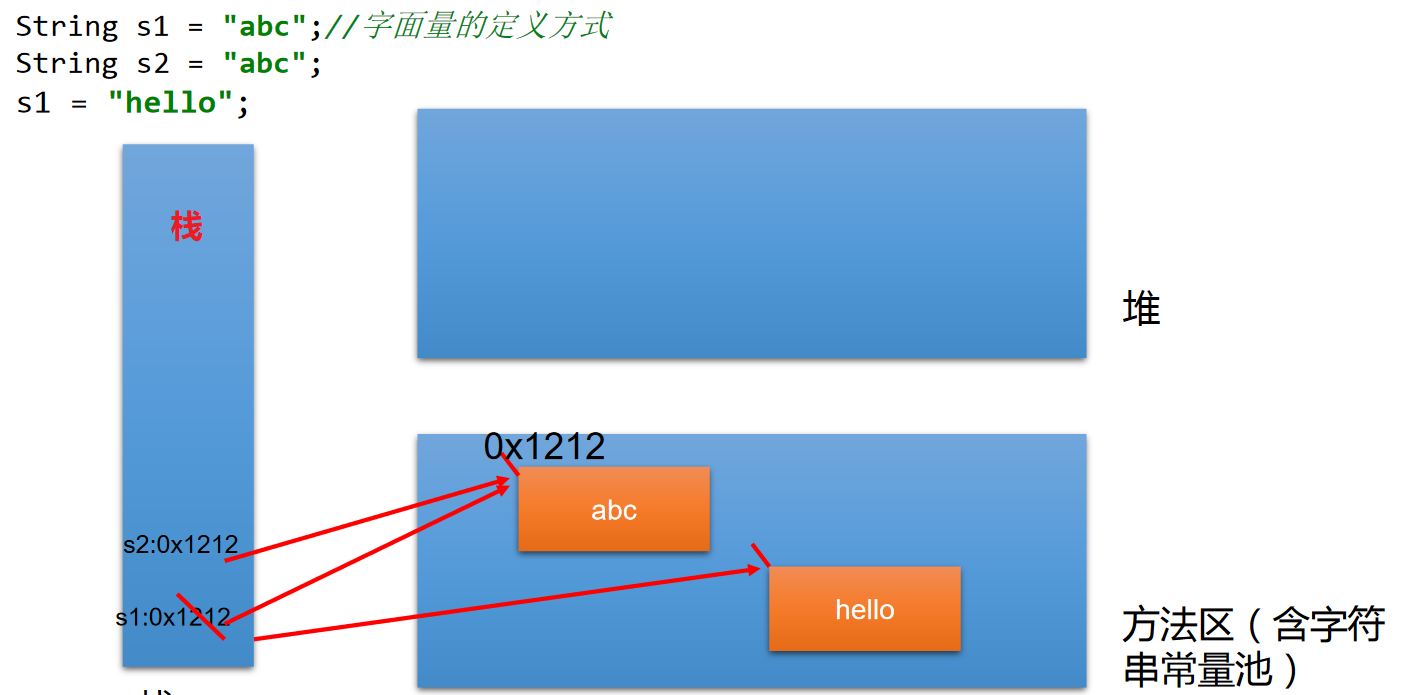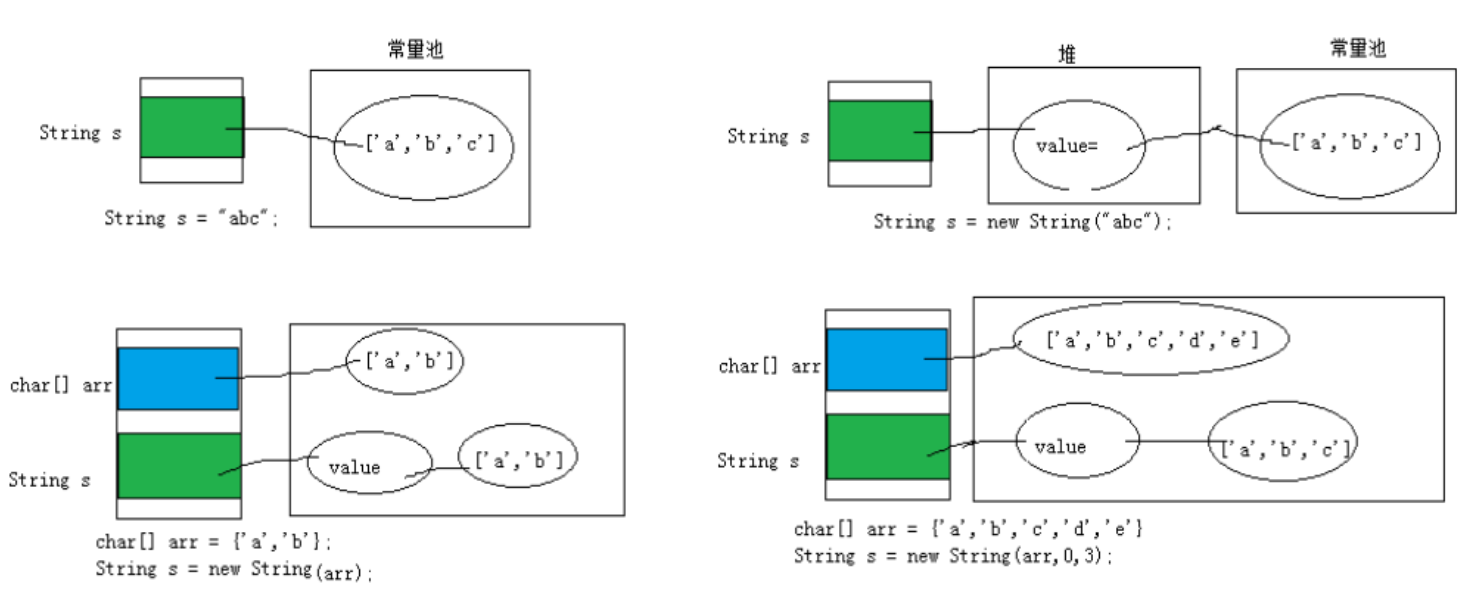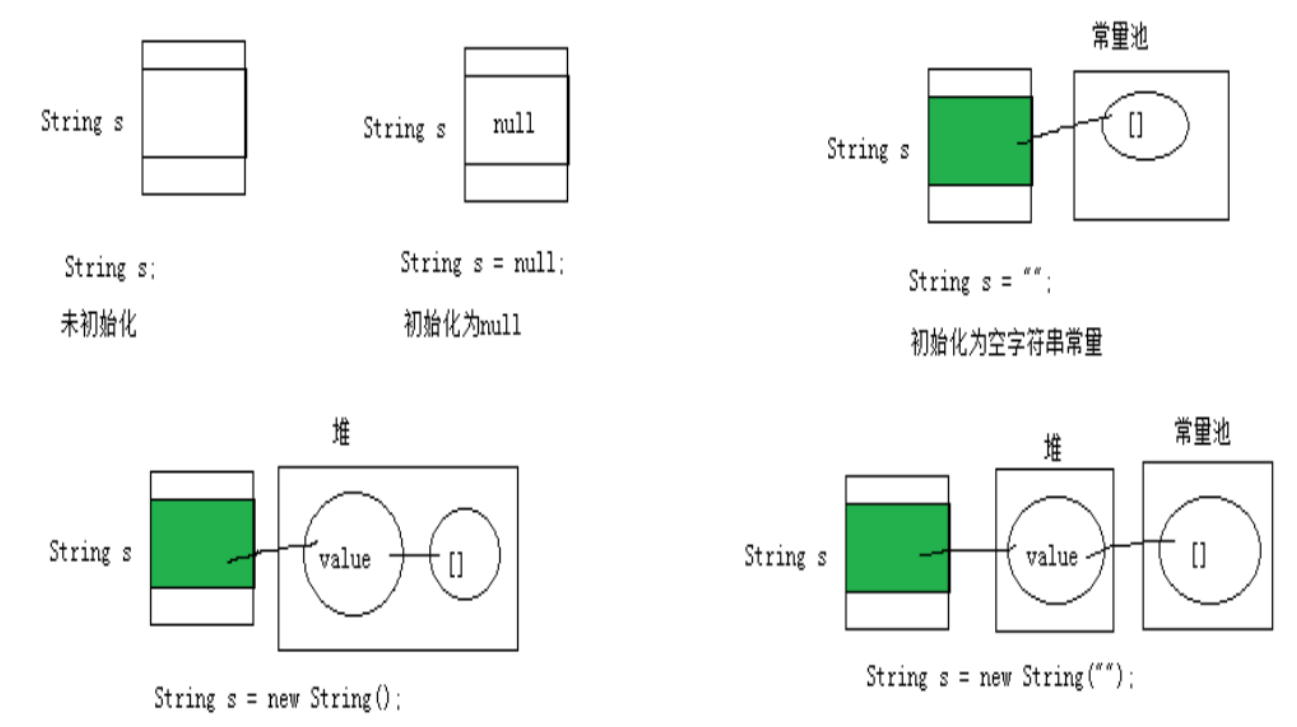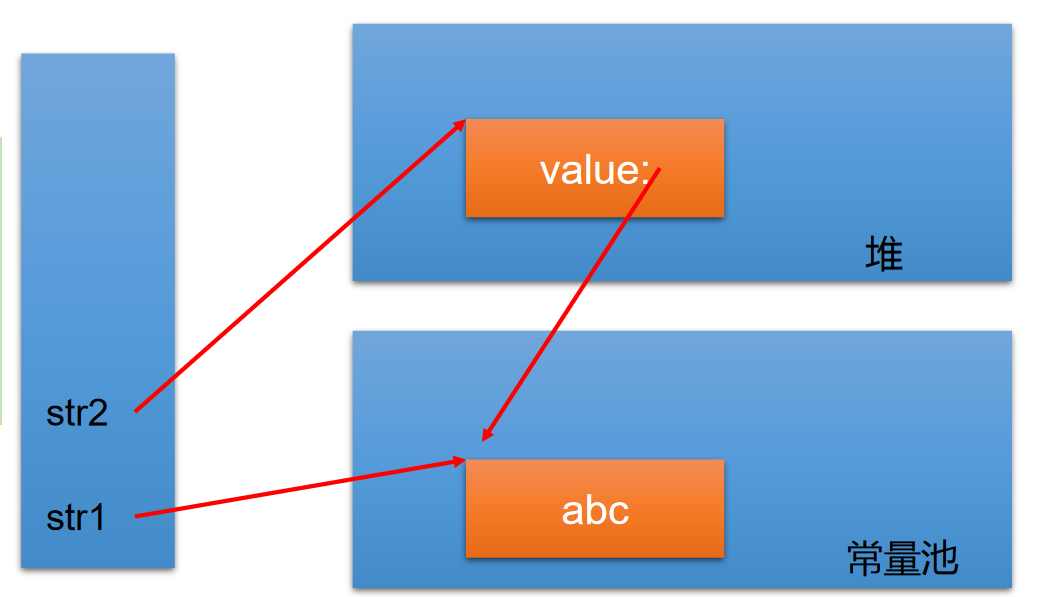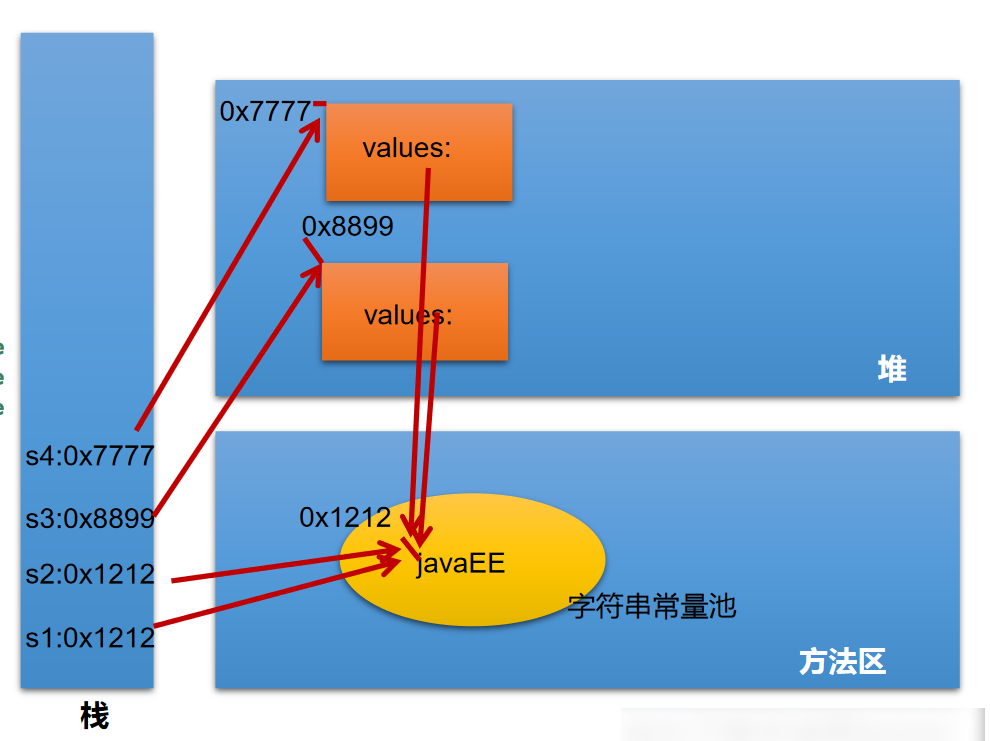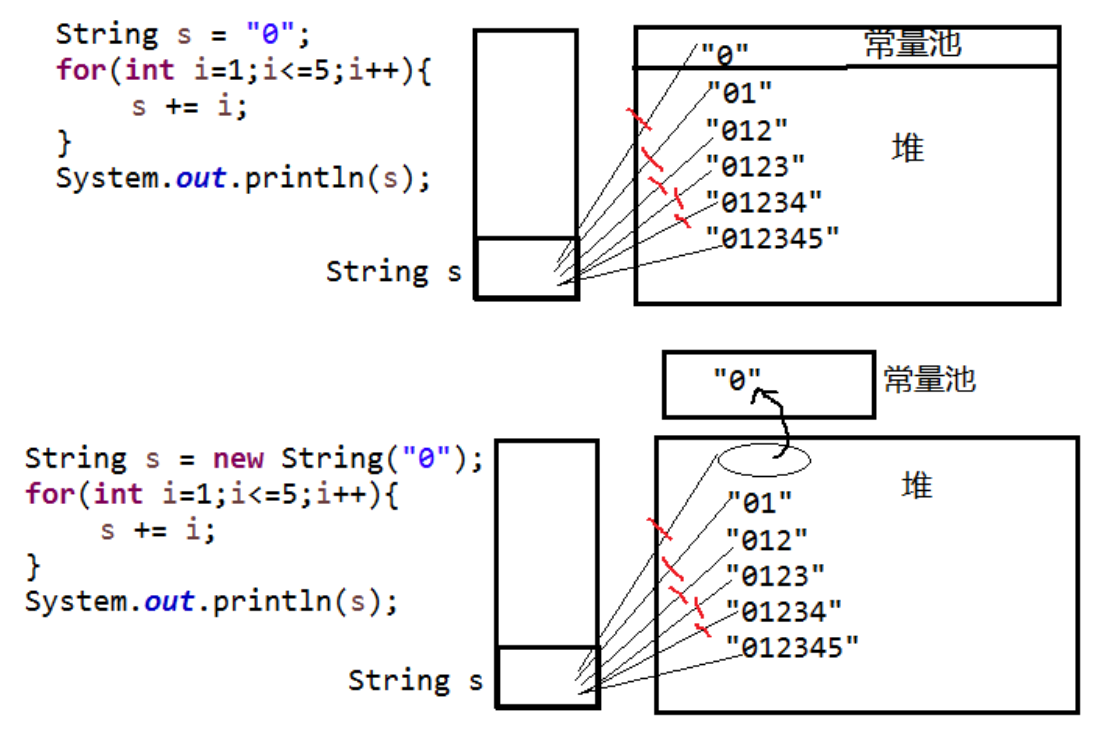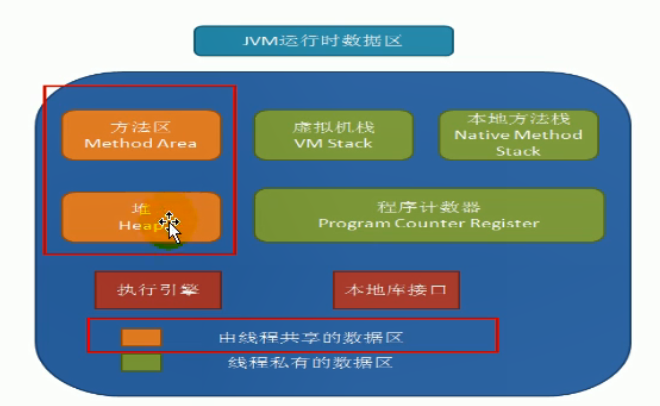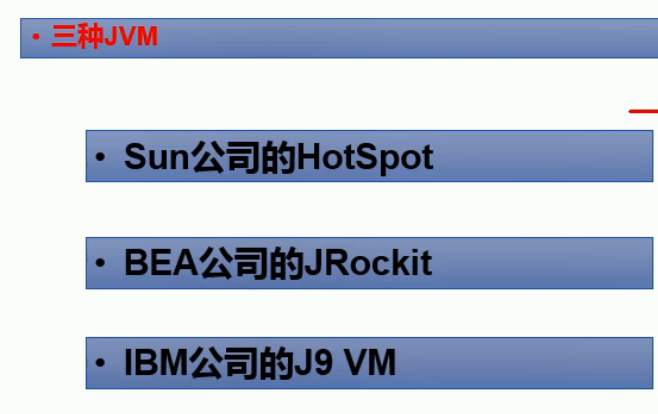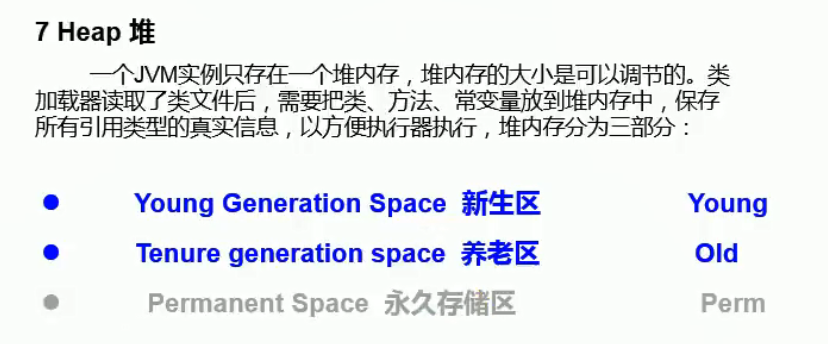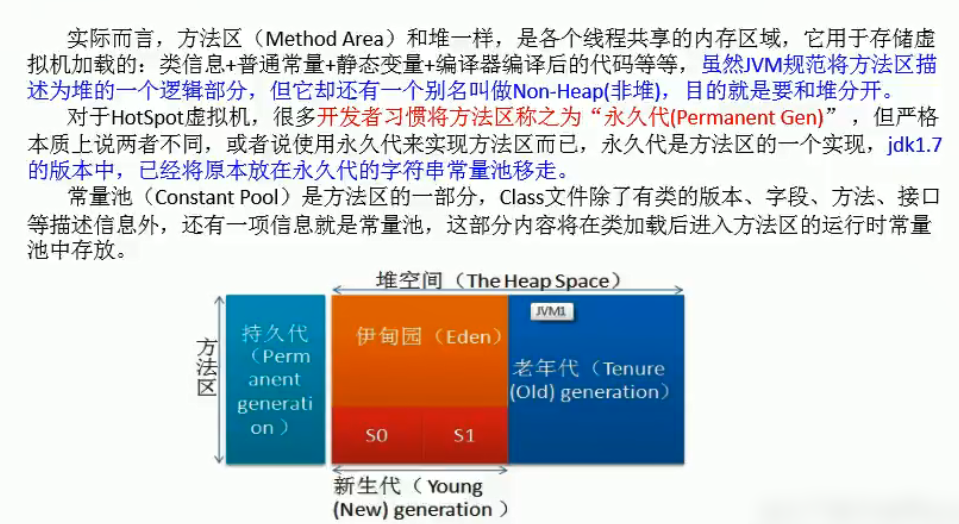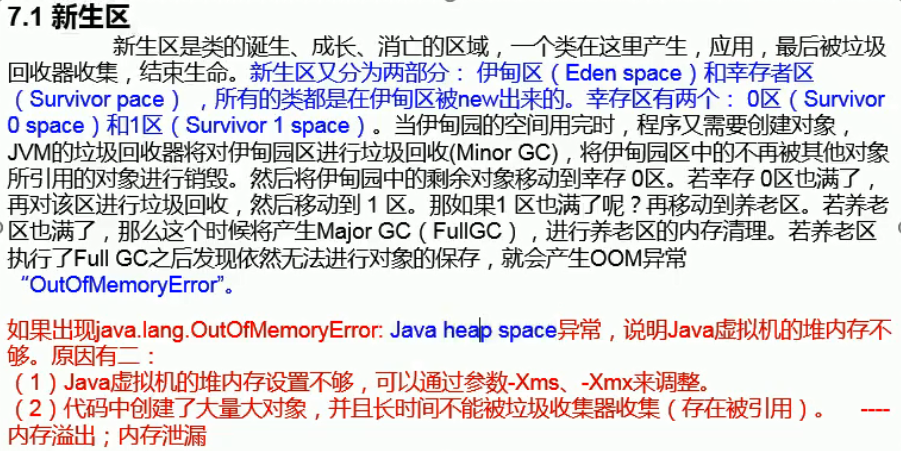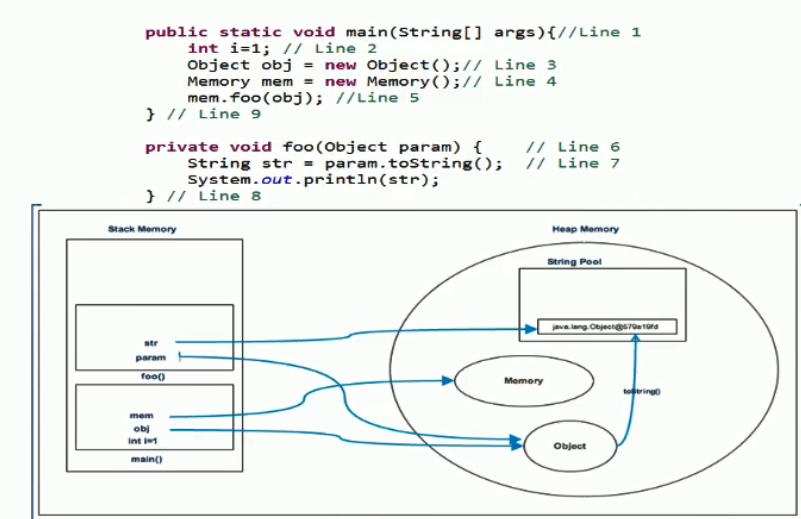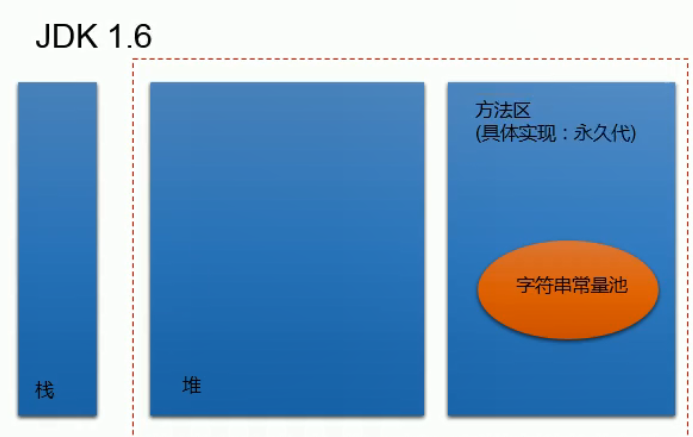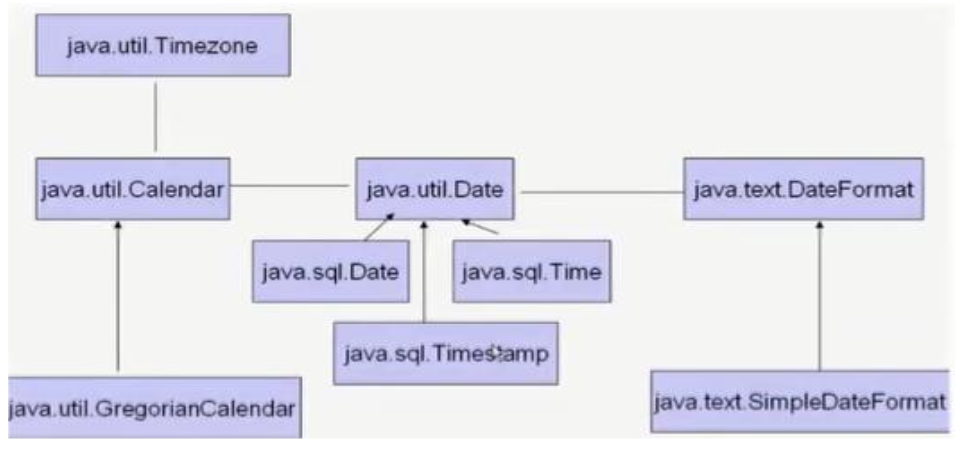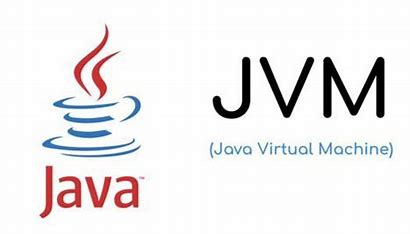常用类 1.字符串相关的类 1.String类的概述 1 2 3 4 5 6 7 8 9 10 11 12 13 14 15 16 17 18 19 import org.junit.Test;public class StringTest { @Test public void Test1 () { } }
2.理解String的不可变性 1 2 3 4 5 6 7 8 9 10 11 12 13 14 15 16 17 18 19 20 21 22 23 24 25 26 27 28 29 30 31 32 33 34 35 36 37 38 39 40 41 42 43 import org.junit.Test;public class StringTest { @Test public void Test1 () { String s1 = "abc" ; String s2 = "abc" ; s1 = "hello" ; System.out.println(s1 == s2); System.out.println(s1); System.out.println(s2); System.out.println("*********************" ); String s3 = "abc" ; s3 += "def" ; System.out.println(s3); System.out.println("**********************" ); String s4 = "abc" ; String s5 = s4.replace('a' , 'm' ); System.out.println(s4); System.out.println(s5); } }
3.String不同实例化方式的对比 1 2 3 4 5 6 7 8 9 10 11 12 String str = "hello" ;String s1 = new String (); String s2 = new String (String original); String s3 = new String (char [] a);String s4 = new String (char [] a,int startIndex,int count);
String str1 = “abc”;与String str2 = new String(“abc”);的区别?字符串常量存储在字符串常量池,目的是共享 字符串非常量对象存储在堆中。
练习 1 2 3 4 5 6 7 8 9 10 11 12 13 14 15 16 17 18 19 20 21 22 23 24 25 26 27 28 29 30 31 32 33 34 35 36 37 38 39 40 import org.junit.Test;public class StringTest { @Test public void test2 () { String s1 = "javaEE" ; String s2 = "javaEE" ; String s3 = new String ("javaEE" ); String s4 = new String ("javaEE" ); System.out.println(s1 == s2); System.out.println(s1 == s3); System.out.println(s1 == s4); System.out.println(s3 == s4); System.out.println("***********************" ); Person p1 = new Person ("Tom" ,12 ); Person p2 = new Person ("Tom" ,12 ); System.out.println(p1.name.equals(p2.name)); System.out.println(p1.name == p2.name); p1.name = "Jerry" ; System.out.println(p2.name); } }
1 2 3 4 5 6 7 8 9 10 11 12 13 14 public class Person { String name; int age; public Person (String name, int age) { this .name = name; this .age = age; } public Person () { } }
4.String不同拼接操作的对比 1 2 3 4 5 6 7 8 9 10 11 12 13 14 15 16 17 18 19 20 21 22 23 24 25 26 27 28 29 30 31 32 33 34 35 36 37 38 39 40 41 42 43 44 45 46 47 48 import org.junit.Test;public class StringTest { @Test public void test4 () { String s1 = "javaEEhadoop" ; String s2 = "javaEE" ; String s3 = s2 + "hadoop" ; System.out.println(s1 == s3); final String s4 = "javaEE" ; String s5 = s4 + "hadoop" ; System.out.println(s1 == s5); } @Test public void test3 () { String s1 = "javaEE" ; String s2 = "hadoop" ; String s3 = "javaEEhadoop" ; String s4 = "javaEE" + "hadoop" ; String s5 = s1 + "hadoop" ; String s6 = "javaEE" + s2; String s7 = s1 + s2; System.out.println(s3 == s4); System.out.println(s3 == s5); System.out.println(s3 == s6); System.out.println(s5 == s6); System.out.println(s3 == s7); System.out.println(s5 == s6); System.out.println(s5 == s7); System.out.println(s6 == s7); String s8 = s5.intern(); System.out.println(s3 == s8); } }
String使用陷阱 String s1 = “a”;
说明:在字符串常量池中创建了一个字面量为”a”的字符串。
s1 = s1 + “b”;
说明:实际上原来的“a”字符串对象已经丢弃了,现在在堆空间中产生了一个字符串s1+”b”(也就是”ab”)。如果多次执行这些改变串内容的操作,会导致大量副本字符串对象存留在内存中,降低效率。如果这样的操作放到循环中,会极大影响程序的性能。
String s2 = “ab”;
说明:直接在字符串常量池中创建一个字面量为”ab”的字符串。
String s3 = “a” + “b”;
说明:s3指向字符串常量池中已经创建的”ab”的字符串。
String s4 = s1.intern();
说明:堆空间的s1对象在调用intern()之后,会将常量池中已经存在的”ab”字符串赋值给s4。
练习
5.String的一道面试题 1 2 3 4 5 6 7 8 9 10 11 12 13 14 15 public class StringTest { String str = new String ("good" ); char [] ch = { 't' , 'e' , 's' , 't' }; public void change (String str, char ch[]) { str = "test ok" ; ch[0 ] = 'b' ; } public static void main (String[] args) { StringTest ex = new StringTest (); ex.change(ex.str, ex.ch); System.out.println(ex.str); System.out.println(ex.ch); } }
6.JVM中涉及字符串的内存结构
7.String的常用方法1 1 2 3 4 5 6 7 8 9 10 11 12 13 14 15 16 17 18 19 20 21 22 23 24 25 26 27 28 29 30 31 32 33 34 35 36 37 38 39 40 41 42 43 44 45 46 47 48 49 50 51 52 53 54 55 56 57 58 59 60 61 62 63 64 65 import org.junit.Test;public class StringMethodTest { @Test public void test2 () { String s1 = "HelloWorld" ; String s2 = "helloworld" ; System.out.println(s1.equals(s2)); System.out.println(s1.equalsIgnoreCase(s2)); String s3 = "abc" ; String s4 = s3.concat("def" ); System.out.println(s4); String s5 = "abc" ; String s6 = new String ("abe" ); System.out.println(s5.compareTo(s6)); String s7 = "周围好吵啊" ; String s8 = s7.substring(2 ); System.out.println(s7); System.out.println(s8); String s9 = s7.substring(0 , 2 ); System.out.println(s9); } @Test public void Test1 () { String s1 = "helloworld" ; System.out.println(s1.length()); System.out.println(s1.length()); System.out.println(s1.charAt(0 )); System.out.println(s1.charAt(9 )); System.out.println(s1.isEmpty()); String s2 = s1.toLowerCase(); System.out.println(s1); System.out.println(s2); String s3 = " he llo world " ; String s4 = s3.trim(); System.out.println("-----" + s3 + "-----" ); System.out.println("-----" + s4 + "-----" ); } }
8.String的常用方法2 1 2 3 4 5 6 7 8 9 10 11 12 13 14 15 16 17 18 19 20 21 22 23 24 25 26 27 28 29 30 31 32 33 34 35 36 37 38 39 40 41 42 43 44 45 import org.junit.Test;public class StringMethodTest { @Test public void test3 () { String str1 = "helloworld" ; boolean b1 = str1.endsWith("rld" ); System.out.println(b1); boolean b2 = str1.startsWith("He" ); System.out.println(b2); boolean b3 = str1.startsWith("ll" ,2 ); System.out.println(b3); String str2 = "wor" ; System.out.println(str1.contains(str2)); System.out.println(str1.indexOf("lo" )); System.out.println(str1.indexOf("lo" ,5 )); String str3 = "hellorworld" ; System.out.println(str3.lastIndexOf("or" )); System.out.println(str3.lastIndexOf("or" ,6 )); } }
9.String的常用方法3 1 2 3 4 5 6 7 8 9 10 11 12 13 14 15 16 17 18 19 20 21 22 23 24 25 26 27 28 29 30 31 32 33 34 35 36 37 38 39 40 41 42 43 44 45 46 47 48 49 50 51 52 53 54 55 56 57 58 59 60 import org.junit.Test;public class StringMethodTest { @Test public void test4 () { String str1 = "西藏布达拉宫欢迎您" ; String str2 = str1.replace('西' ,'东' ); System.out.println(str1); System.out.println(str2); String str3 = str1.replace("北京" , "南京" ); System.out.println(str3); System.out.println("*************************" ); String str = "12hello34world5java7891mysql456" ; String string = str.replaceAll("\\d+" , "," ).replaceAll("^,|,$" , "" ); System.out.println(string); System.out.println("*************************" ); str = "12345" ; boolean matches = str.matches("\\d+" ); System.out.println(matches); String tel = "0571-4534289" ; boolean result = tel.matches("0571-\\d{7,8}" ); System.out.println(result); System.out.println("*************************" ); str = "hello|world|java" ; String[] strs = str.split("\\|" ); for (int i = 0 ; i < strs.length; i++) { System.out.println(strs[i]); } System.out.println(); str2 = "hello.world.java" ; String[] strs2 = str2.split("\\." ); for (int i = 0 ; i < strs2.length; i++) { System.out.println(strs2[i]); } } }
10.回顾String与基本数据类型包装类的转换 1 2 3 4 5 6 7 8 9 10 11 12 13 14 15 16 17 18 19 20 21 22 23 24 import org.junit.Test;public class StringTest1 { @Test public void test1 () { String str1 = "123" ; int num = Integer.parseInt(str1); String str2 = String.valueOf(num); String str3 = num + "" ; System.out.println(str1 == str3); } }
11.String与char[]之间的转换 1 2 3 4 5 6 7 8 9 10 11 12 13 14 15 16 17 18 19 20 21 22 23 24 import org.junit.Test;public class StringTest1 { @Test public void test2 () { String str1 = "abc123" ; char [] charArray = str1.toCharArray(); for (int i = 0 ; i < charArray.length; i++) { System.out.println(charArray[i]); } char [] arr = new char []{'h' ,'e' ,'l' ,'l' ,'o' }; String str2 = new String (arr); System.out.println(str2); } }
12.String与byte[]之间的转换 1 2 3 4 5 6 7 8 9 10 11 12 13 14 15 16 17 18 19 20 21 22 23 24 25 26 27 28 29 30 31 32 33 34 35 36 37 38 39 40 import org.junit.Test;import java.io.UnsupportedEncodingException;import java.util.Arrays;public class StringTest1 { @Test public void test3 () throws UnsupportedEncodingException { String str1 = "abc123重工" ; byte [] bytes = str1.getBytes(); System.out.println(Arrays.toString(bytes)); byte [] gbks = str1.getBytes("gbk" ); System.out.println(Arrays.toString(gbks)); System.out.println("*****************************" ); String str2 = new String (bytes); System.out.println(str2); String str3 = new String (gbks); System.out.println(str3); String str4 = new String (gbks,"gbk" ); System.out.println(str4); } }
13.面试中String算法考查的说明 1.模拟一个trim方法,去除字符串两端的空格。
1 2 3 4 5 6 7 8 9 10 11 12 13 14 15 16 17 18 19 20 21 22 23 24 25 26 27 28 29 30 31 32 33 34 import org.junit.Test;public class StringExer { public String myTrim (String str) { if (str != null ) { int start = 0 ; int end = str.length() - 1 ; while (start < end && str.charAt(start) == ' ' ) { start++; } while (start < end && str.charAt(end) == ' ' ) { end--; } if (str.charAt(start) == ' ' ) { return "" ; } return str.substring(start, end + 1 ); } return null ; } @Test public void testMyTrim () { String str = " a " ; String newStr = myTrim(str); System.out.println("---" + newStr + "---" ); } }
2.将一个字符串进行反转。将字符串中指定部分进行反转。比如“abcdefg”反转为”abfedcg”
1 2 3 4 5 6 7 8 9 10 11 12 13 14 15 16 17 18 19 20 21 22 23 24 25 26 27 28 29 30 31 32 33 34 35 36 37 38 39 40 41 42 43 44 45 46 47 48 49 50 51 52 53 54 55 56 57 58 59 60 61 62 63 64 65 66 67 68 69 70 71 import org.junit.Test;public class StringDemo { public String reverse (String str,int startIndex,int endIndex) { if (str != null && str.length() != 0 ) { char [] arr = str.toCharArray(); for (int x = startIndex, y = endIndex; x < y; x++, y--) { char temp = arr[x]; arr[x] = arr[y]; arr[y] = temp; } return new String (arr); } return null ; } public String reverse2 (String str, int startIndex, int endIndex) { if (str != null ) { String reverStr = str.substring(0 ,startIndex); for (int i = endIndex; i >= startIndex; i--) { reverStr += str.charAt(i); } reverStr += str.substring(endIndex + 1 ); return reverStr; } return null ; } public String reverse3 (String str, int startIndex, int endIndex) { StringBuilder builder = new StringBuilder (str.length()); if (str != null ) { builder.append(str.substring(0 , startIndex)); for (int i = endIndex; i >= startIndex; i--) { builder.append(str.charAt(i)); } builder.append(str.substring(endIndex + 1 )); return builder.toString(); } return null ; } @Test public void testReverse () { String str = "abcdefg" ; String str1 = reverse3(str, 2 , 5 ); System.out.println(str1); } }
3.获取一个字符串在另一个字符串中出现的次数。比如:获取“ ab”在“abkkcadkabkebfkabkskab” 中出现的次数
1 2 3 4 5 6 7 8 9 10 11 12 13 14 15 16 17 18 19 20 21 22 23 24 25 26 27 28 29 30 31 32 33 34 35 36 37 38 39 40 41 42 43 44 45 46 47 48 import org.junit.Test;public class StringDemo2 { public int getCount (String mainStr,String subStr) { int mainLength = mainStr.length(); int subLength = subStr.length(); int count = 0 ; int index = 0 ; if (mainLength >= subLength){ while ((index = mainStr.indexOf(subStr,index)) != -1 ){ count++; index += subLength; } return count; }else { return 0 ; } } @Test public void testGetCount () { String mainStr = "abkkcadkabkebfkabkskab" ; String subStr = "ab" ; int count = getCount(mainStr,subStr); System.out.println(count); } }
4.获取两个字符串中最大相同子串。比如:
str1 = “abcwerthelloyuiodef“;str2 = “cvhellobnm”
提示:将短的那个串进行长度依次递减的子串与较长的串比较。
1 2 3 4 5 6 7 8 9 10 11 12 13 14 15 16 17 18 19 20 21 22 23 24 25 26 27 28 29 30 31 32 33 34 35 36 37 38 39 40 41 42 43 44 45 46 47 48 49 50 51 52 53 54 55 56 57 58 59 60 61 62 63 64 65 66 67 68 69 import org.junit.Test;import java.util.Arrays;public class StringDemo3 { public String getMaxSameString (String str1,String str2) { if (str1 != null && str2 != null ){ String maxStr = (str1.length() >= str2.length())? str1 : str2; String minStr = (str1.length() < str2.length())? str1 : str2; int length = minStr.length(); for (int i = 0 ;i < length;i++){ for (int x = 0 ,y = length - i;y <= length;x++,y++){ String subStr = minStr.substring(x,y); if (maxStr.contains(subStr)){ return subStr; } } } } return null ; } public String[] getMaxSameString1(String str1, String str2) { if (str1 != null && str2 != null ) { StringBuffer sBuffer = new StringBuffer (); String maxString = (str1.length() > str2.length()) ? str1 : str2; String minString = (str1.length() > str2.length()) ? str2 : str1; int len = minString.length(); for (int i = 0 ; i < len; i++) { for (int x = 0 , y = len - i; y <= len; x++, y++) { String subString = minString.substring(x, y); if (maxString.contains(subString)) { sBuffer.append(subString + "," ); } } if (sBuffer.length() != 0 ) { break ; } } String[] split = sBuffer.toString().replaceAll(",$" , "" ).split("\\," ); return split; } return null ; } @Test public void testGetMaxSameString () { String str1 = "abcwerthello1yuiodefabcdef" ; String str2 = "cvhello1bnmabcdef" ; String[] maxSameStrings = getMaxSameString1(str1, str2); System.out.println(Arrays.toString(maxSameStrings)); } }
5.对字符串中字符进行自然顺序排序。
提示:
1)字符串变成字符数组。
2)对数组排序,选择,冒泡,Arrays.sort();
3)将排序后的数组变成字符串。
1 2 3 4 5 6 7 8 9 10 11 12 13 14 15 16 17 18 19 20 21 22 23 24 25 26 import org.junit.Test;import java.util.Arrays;public class StringDemo4 { @Test public void testSort () { String str = "abcwerthelloyuiodef" ; char [] arr = str.toCharArray(); Arrays.sort(arr); String newStr = new String (arr); System.out.println(newStr); } }
14.StringBuffer和StringBuilder的介绍 15.StringBuffer的源码分析 1 2 3 4 5 6 7 8 9 10 11 12 13 14 15 16 17 18 19 20 21 22 23 24 25 26 27 28 29 30 31 32 33 import org.junit.Test;public class StringBufferBuilderTest { @Test public void test1 () { StringBuffer sb1 = new StringBuffer ("abc" ); sb1.setCharAt(0 ,'m' ); System.out.println(sb1); StringBuffer sb2 = new StringBuffer (); System.out.println(sb2.length()); } }
16.StringBuffer中的常用方法 1 2 3 4 5 6 7 8 9 10 11 12 13 14 15 16 17 18 19 20 21 22 23 24 25 26 27 28 29 30 31 32 33 34 35 36 37 38 39 40 41 42 43 44 import org.junit.Test;public class StringBufferBuilderTest { @Test public void test2 () { StringBuffer s1 = new StringBuffer ("abc" ); s1.append(1 ); s1.append('1' ); System.out.println(s1); String s2 = s1.substring(1 ,3 ); System.out.println(s1); System.out.println(s1.length()); System.out.println(s2); } }
17.String、StringBuffer、StringBuilder效率对比 1 2 3 4 5 6 7 8 9 10 11 12 13 14 15 16 17 18 19 20 21 22 23 24 25 26 27 28 29 30 31 32 33 34 35 36 37 38 39 40 41 import org.junit.Test;public class StringBufferBuilderTest { @Test public void test3 () { long startTime = 0L ; long endTime = 0L ; String text = "" ; StringBuffer buffer = new StringBuffer ("" ); StringBuilder builder = new StringBuilder ("" ); startTime = System.currentTimeMillis(); for (int i = 0 ; i < 20000 ; i++) { buffer.append(String.valueOf(i)); } endTime = System.currentTimeMillis(); System.out.println("StringBuffer的执行时间:" + (endTime - startTime)); startTime = System.currentTimeMillis(); for (int i = 0 ; i < 20000 ; i++) { builder.append(String.valueOf(i)); } endTime = System.currentTimeMillis(); System.out.println("StringBuilder的执行时间:" + (endTime - startTime)); startTime = System.currentTimeMillis(); for (int i = 0 ; i < 20000 ; i++) { text = text + i; } endTime = System.currentTimeMillis(); System.out.println("String的执行时间:" + (endTime - startTime)); } }
2.JDK 8之前的日期时间API
1.System类中获取时间戳的方法 System类提供的public static long currentTimeMillis()用来返回当前时间与1970年1月1日0时0分0秒之间以毫秒为单位的时间差。
此方法适于计算时间差。 计算世界时间的主要标准有:UTC(Coordinated Universal Time) GMT(Greenwich Mean Time) CST(Central Standard Time) 1 2 3 4 5 6 7 8 9 10 11 12 13 import org.junit.Test;public class DateTimeTest { @Test public void test1 () { long time = System.currentTimeMillis(); System.out.println(time); } }
2.Java中两个Date类的使用 1 2 3 4 5 6 7 8 9 10 11 12 13 14 15 16 17 18 19 20 21 22 23 24 25 26 27 28 29 30 31 32 33 34 35 36 37 38 39 40 41 42 43 44 45 46 47 import org.junit.Test;import java.util.Date;public class DateTimeTest { @Test public void test2 () { Date date1 = new Date (); System.out.println(date1.toString()); System.out.println(date1.getTime()); Date date2 = new Date (1589026216998L ); System.out.println(date2.toString()); java.sql.Date date3 = new java .sql.Date(35235325345L ); System.out.println(date3); Date date6 = new Date (); java.sql.Date date7 = new java .sql.Date(date6.getTime()); } }
Date类的API不易于国际化,大部分被废弃了,java.text.SimpleDateFormat类是一个不与语言环境有关的方式来格式化和解析日期的具体类。 它允许进行 1 2 3 4 5 6 7 8 9 10 11 12 13 14 15 16 17 18 19 20 21 22 23 24 25 26 27 28 29 30 31 32 33 34 35 36 37 38 39 40 41 42 43 44 45 46 47 48 49 50 51 import org.junit.Test;import java.text.ParseException;import java.text.SimpleDateFormat;import java.util.Date;public class DateTime { @Test public void testSimpleDateFormat () throws ParseException { SimpleDateFormat sdf = new SimpleDateFormat (); Date date = new Date (); System.out.println(date); String format = sdf.format(date); System.out.println(format); String str = "19-12-18 上午11:43" ; Date date1 = sdf.parse(str); System.out.println(date1); SimpleDateFormat sdf1 = new SimpleDateFormat ("yyyyy.MMMMM.dd GGG hh:mm aaa" ); String format1 = sdf1.format(date); System.out.println(format1); Date date2 = sdf1.parse("02020.五月.10 公元 04:32 下午" ); System.out.println(date2); } }
1 2 3 4 5 6 7 8 9 10 11 12 13 14 15 16 17 18 19 20 21 22 23 24 25 26 27 28 29 30 31 import org.junit.Test;import java.text.ParseException;import java.text.SimpleDateFormat;import java.util.Date;public class DateTime { @Test public void testExer () throws ParseException { String birth = "2020-09-08" ; SimpleDateFormat sdf1 = new SimpleDateFormat ("yyyy-MM-dd" ); Date date = sdf1.parse(birth); java.sql.Date birthDate = new java .sql.Date(date.getTime()); System.out.println(birthDate); } }
5.Calendar日历类的使用 Calendar是一个抽象基类,主用用于完成日期字段之间相互操作的功能。 获取Calendar实例的方法使用Calendar.getInstance()方法 调用它的子类GregorianCalendar的构造器。 一个Calendar的实例是系统时间的抽象表示,通过get(intfield)方法来取得想要的时间信息。比如YEAR、MONTH、DAY_OF_WEEK、HOUR_OF_DAY 、MINUTE、SECONDpublic void set(intfield,intvalue) public void add(intfield,intamount) public final Date getTime() public final void setTime(Date date) 注意:获取月份时:一月是0,二月是1,以此类推,12月是11 获取星期时:周日是1,周二是2,。。。。周六是7 1 2 3 4 5 6 7 8 9 10 11 12 13 14 15 16 17 18 19 20 21 22 23 24 25 26 27 28 29 30 31 32 33 34 35 36 37 38 39 40 41 42 43 44 45 46 47 48 49 50 51 52 53 54 import java.util.Calendar;import java.util.Date;import org.junit.Test;public class DateTime { @Test public void testCalendar () { Calendar calendar = Calendar.getInstance(); int days = calendar.get(Calendar.DAY_OF_MONTH); System.out.println(days); System.out.println(calendar.get(Calendar.DAY_OF_YEAR)); calendar.set(Calendar.DAY_OF_MONTH,22 ); days = calendar.get(Calendar.DAY_OF_MONTH); System.out.println(days); calendar.add(Calendar.DAY_OF_MONTH,-3 ); days = calendar.get(Calendar.DAY_OF_MONTH); System.out.println(days); Date date = calendar.getTime(); System.out.println(date); Date date1 = new Date (); calendar.setTime(date1); days = calendar.get(Calendar.DAY_OF_MONTH); System.out.println(days); } }
3.JDK8中日期时间API的介绍 如果我们可以跟别人说:“我们在1502643933071见面,别晚了!”那么就再简单不过了。但是我们希望时间与昼夜和四季有关,于是事情就变复杂了。JDK 1.0中包含了一个java.util.Date类,但是它的大多数方法已经在JDK 1.1引入Calendar类之后被弃用了。而Calendar并不比Date好多少。它们面临的问题是:
可变性:像日期和时间这样的类应该是不可变的。
偏移性:Date中的年份是从1900开始的,而月份都从0开始。
格式化:格式化只对Date有用,Calendar则不行。
此外,它们也不是线程安全的;不能处理闰秒等。
总结:对日期和时间的操作一直是Java程序员最痛苦的地方之一。
1 2 3 4 5 6 7 8 9 10 11 12 13 14 15 import org.junit.Test;import java.util.Date;public class JDK8DateTimeTest { @Test public void testDate () { Date date1 = new Date (2020 ,9 ,8 ); System.out.println(date1); Date date2 = new Date (2020 - 1900 ,9 - 1 ,8 ); System.out.println(date2); } }
第三次引入的API是成功的,并且Java 8中引入的java.time API 已经纠正了过去的缺陷,将来很长一段时间内它都会为我们服务。 Java 8 吸收了Joda-Time 的精华,以一个新的开始为Java 创建优秀的API。新的java.time 中包含了所有关于本地日期(LocalDate)、本地时间(LocalTime)、本地日期时间(LocalDateTime)、时区(ZonedDateTime)和持续时间(Duration)的类 。历史悠久的Date 类新增了toInstant() 方法,用于把Date 转换成新的表示形式。这些新增的本地化时间日期API 大大简化了日期时间和本地化的管理。 1 2 3 4 java.time–包含值对象的基础包 java.time.chrono–提供对不同的日历系统的访问java.time.format–格式化和解析时间和日期java.time.temporal–包括底层框架和扩展特性java.time.zone–包含时区支持的类 说明:大多数开发者只会用到基础包和format包,也可能会用到temporal包。因此,尽管有68 个新的公开类型,大多数开发者,大概将只会用到其中的三分之一。
1.LocalDate、LocalTime、LocalDateTime的使用 1 2 3 4 5 6 7 8 9 10 11 12 13 14 15 16 17 18 19 20 21 22 23 24 25 26 27 28 29 30 31 32 33 34 35 36 37 38 39 40 41 42 43 44 45 46 47 48 49 50 51 52 53 54 import org.junit.Test;import java.time.LocalDate;import java.time.LocalDateTime;import java.time.LocalTime;public class JDK8DateTimeTest { @Test public void test1 () { LocalDate localDate = LocalDate.now(); LocalTime localTime = LocalTime.now(); LocalDateTime localDateTime = LocalDateTime.now(); System.out.println(localDate); System.out.println(localTime); System.out.println(localDateTime); LocalDateTime localDateTime1 = LocalDateTime.of(2020 , 10 , 6 , 13 , 23 , 43 ); System.out.println(localDateTime1); System.out.println(localDateTime.getDayOfMonth()); System.out.println(localDateTime.getDayOfWeek()); System.out.println(localDateTime.getMonth()); System.out.println(localDateTime.getMonthValue()); System.out.println(localDateTime.getMinute()); LocalDate localDate1 = localDate.withDayOfMonth(22 ); System.out.println(localDate); System.out.println(localDate1); LocalDateTime localDateTime2 = localDateTime.withHour(4 ); System.out.println(localDateTime); System.out.println(localDateTime2); LocalDateTime localDateTime3 = localDateTime.plusMonths(3 ); System.out.println(localDateTime); System.out.println(localDateTime3); LocalDateTime localDateTime4 = localDateTime.minusDays(6 ); System.out.println(localDateTime); System.out.println(localDateTime4); } }
2.Instant类的使用 Instant:时间线上的一个瞬时点。这可能被用来记录应用程序中的事件时间戳。
在处理时间和日期的时候,我们通常会想到年,月,日,时,分,秒。然而,这只是时间的一个模型,是面向人类的。第二种通用模型是面向机器的,或者说是连续的。在此模型中,时间线中的一个点表示为一个很大的数,这有利于计算机处理。在UNIX中,这个数从1970年开始,以秒为的单位;同样的,在Java中,也是从1970年开始,但以毫秒为单位。
java.time包通过值类型Instant提供机器视图,不提供处理人类意义上的时间单位。Instant表示时间线上的一点,而不需要任何上下文信息,例如,时区。概念上讲,它只是简单的表示自1970年1月1日0时0分0秒(UTC)开始的秒数。因为java.time包是基于纳秒计算的,所以Instant的精度可以达到纳秒级。
(1 ns = 10-9s) 1秒= 1000毫秒=10^6微秒=10^9纳秒
时间戳是指格林威治时间1970年01月01日00时00分00秒(北京时间1970年01月01日08时00分00秒)起至现在的总秒数。
1 2 3 4 5 6 7 8 9 10 11 12 13 14 15 16 17 18 19 20 21 22 23 24 25 26 27 28 import org.junit.Test;import java.time.*;public class JDK8DateTimeTest { @Test public void test2 () { Instant instant = Instant.now(); System.out.println(instant); OffsetDateTime offsetDateTime = instant.atOffset(ZoneOffset.ofHours(8 )); System.out.println(offsetDateTime); long milli = instant.toEpochMilli(); System.out.println(milli); Instant instant1 = Instant.ofEpochMilli(1550475314878L ); System.out.println(instant1); } }
java.time.format.DateTimeFormatter 类:该类提供了三种格式化方法:
预定义的标准格式。如:ISO_LOCAL_DATE_TIME;ISO_LOCAL_DATE;ISO_LOCAL_TIME 本地化相关的格式。如:ofLocalizedDateTime(FormatStyle.LONG) 自定义的格式。如:ofPattern(“yyyy-MM-dd hh:mm:ss”)
1 2 3 4 5 6 7 8 9 10 11 12 13 14 15 16 17 18 19 20 21 22 23 24 25 26 27 28 29 30 31 32 33 34 35 36 37 38 39 40 41 42 43 44 45 46 47 48 49 50 51 52 53 54 55 import org.junit.Test;import java.time.*;import java.time.format.DateTimeFormatter;import java.time.format.FormatStyle;import java.time.temporal.TemporalAccessor;public class JDK8DateTimeTest { @Test public void test3 () { DateTimeFormatter formatter = DateTimeFormatter.ISO_LOCAL_DATE_TIME; LocalDateTime localDateTime = LocalDateTime.now(); String str1 = formatter.format(localDateTime); System.out.println(localDateTime); System.out.println(str1); TemporalAccessor parse = formatter.parse("2020-05-10T18:26:40.234" ); System.out.println(parse); DateTimeFormatter formatter1 = DateTimeFormatter.ofLocalizedDateTime(FormatStyle.LONG); String str2 = formatter1.format(localDateTime); System.out.println(str2); DateTimeFormatter formatter2 = DateTimeFormatter.ofLocalizedDate(FormatStyle.MEDIUM); String str3 = formatter2.format(LocalDate.now()); System.out.println(str3); DateTimeFormatter formatter3 = DateTimeFormatter.ofPattern("yyyy-MM-dd hh:mm:ss" ); String str4 = formatter3.format(LocalDateTime.now()); System.out.println(str4); TemporalAccessor accessor = formatter3.parse("2020-05-10 06:26:40" ); System.out.println(accessor); } }
4.其它日期时间相关API的使用 ZoneId:该类中包含了所有的时区信息,一个时区的ID,如Europe/Paris ZonedDateTime:一个在ISO-8601日历系统时区的日期时间,如2007-12-03T10:15:30+01:00Europe/Paris。其中每个时区都对应着ID,地区ID都为“{区域}/{城市}”的格式,例如:Asia/Shanghai等 1 2 3 4 5 6 7 8 9 10 11 12 13 14 15 16 17 18 19 20 21 22 23 24 25 26 27 28 import org.junit.Test;import java.time.*;import java.util.Set;public class JDK8DateTimeTest { @Test public void test1 () { Set<String> zoneIds= ZoneId.getAvailableZoneIds(); for (String s: zoneIds) { System.out.println(s); } LocalDateTime localDateTime= LocalDateTime.now(ZoneId.of("Asia/Tokyo" )); System.out.println(localDateTime); ZonedDateTime zonedDateTime= ZonedDateTime.now(); System.out.println(zonedDateTime); ZonedDateTime zonedDateTime1= ZonedDateTime.now(ZoneId.of("Asia/Tokyo" )); System.out.println(zonedDateTime1); } }
Clock:使用时区提供对当前即时、日期和时间的访问的时钟。 持续时间:Duration,用于计算两个“时间”间隔 日期间隔:Period,用于计算两个“日期”间隔 TemporalAdjuster : 时间校正器。有时我们可能需要获取例如:将日期调整到“下一个工作日”等操作。 TemporalAdjusters : 该类通过静态方法(firstDayOfXxx()/lastDayOfXxx()/nextXxx())提供了大量的常用TemporalAdjuster 的实现。 1 2 3 4 5 6 7 8 9 10 11 12 13 14 15 16 17 18 19 20 21 22 23 24 25 26 27 import java.time.Duration;import java.time.LocalDateTime;import java.time.LocalTime;import org.junit.Test;public class JDK8APITest { @Test public void test2 () { LocalTime localTime= LocalTime.now(); LocalTime localTime1= LocalTime.of(15 , 23 , 32 ); Duration duration= Duration.between(localTime1, localTime); System.out.println(duration); System.out.println(duration.getSeconds()); System.out.println(duration.getNano()); LocalDateTime localDateTime= LocalDateTime.of(2016 , 6 , 12 , 15 , 23 , 32 ); LocalDateTime localDateTime1= LocalDateTime.of(2017 , 6 , 12 , 15 , 23 , 32 ); Duration duration1= Duration.between(localDateTime1, localDateTime); System.out.println(duration1.toDays()); } }
1 2 3 4 5 6 7 8 9 10 11 12 13 14 15 16 17 18 19 20 21 import java.time.Period;import org.junit.Test;public class JDK8APITest { @Test public void test3 () { LocalDate localDate= LocalDate.now(); LocalDate localDate1= LocalDate.of(2028 , 3 , 18 ); Period period= Period.between(localDate, localDate1); System.out.println(period);System.out.println(period.getYears()); System.out.println(period.getMonths()); System.out.println(period.getDays()); Period period1= period.withYears(2 ); System.out.println(period1); } }
5.参考:与传统日期处理的转换
4.Java比较器 1.概述 Java实现对象排序的方式有两种:自然排序:java.lang.Comparable 定制排序:java.util.Comparator 2.Comparable自然排序举例 1 2 3 4 5 6 7 8 9 10 11 12 13 14 15 16 17 18 19 20 21 22 23 24 25 import org.junit.Test;import java.util.Arrays;public class CompareTest { @Test public void test1 () { String[] arr = new String []{"AA" ,"CC" ,"KK" ,"MM" ,"GG" ,"JJ" ,"DD" }; Arrays.sort(arr); System.out.println(Arrays.toString(arr)); } }
2.自定义类实现Comparable自然排序 1 2 3 4 5 6 7 8 9 10 11 12 13 14 15 16 17 18 19 20 21 22 23 24 import org.junit.Test;import java.util.Arrays;public class CompareTest { @Test public void test2 () { Goods[] arr = new Goods [5 ]; arr[0 ] = new Goods ("lenovoMouse" ,34 ); arr[1 ] = new Goods ("dellMouse" ,43 ); arr[2 ] = new Goods ("xiaomiMouse" ,12 ); arr[3 ] = new Goods ("huaweiMouse" ,65 ); arr[4 ] = new Goods ("microsoftMouse" ,43 ); Arrays.sort(arr); System.out.println(Arrays.toString(arr)); } }
1 2 3 4 5 6 7 8 9 10 11 12 13 14 15 16 17 18 19 20 21 22 23 24 25 26 27 28 29 30 31 32 33 34 35 36 37 38 39 40 41 42 43 44 45 46 47 48 49 50 51 52 53 54 55 56 57 58 59 public class Goods implements Comparable { private String name; private double price; public Goods () { } public Goods (String name, double price) { this .name = name; this .price = price; } public String getName () { return name; } public void setName (String name) { this .name = name; } public double getPrice () { return price; } public void setPrice (double price) { this .price = price; } @Override public String toString () { return "Goods{" + "name='" + name + '\'' + ", price=" + price + '}' ; } @Override public int compareTo (Object o) { if (o instanceof Goods){ Goods goods = (Goods)o; if (this .price > goods.price){ return 1 ; }else if (this .price < goods.price){ return -1 ; }else { return -this .name.compareTo(goods.name); } } throw new RuntimeException ("传入的数据类型不一致!" ); } }
3.使用Comparator实现定制排序 1 2 3 4 5 6 7 8 9 10 11 12 13 14 15 16 17 18 19 20 21 22 23 24 25 26 27 28 29 30 31 32 33 34 35 36 37 38 39 40 41 42 43 44 45 46 47 48 49 50 51 52 53 54 55 56 57 58 59 60 61 62 63 64 65 66 67 68 69 70 71 72 73 74 75 76 import org.junit.Test;import java.util.Arrays;import java.util.Comparator;public class CompareTest { @Test public void test3 () { String[] arr = new String []{"AA" ,"CC" ,"KK" ,"MM" ,"GG" ,"JJ" ,"DD" }; Arrays.sort(arr,new Comparator (){ @Override public int compare (Object o1, Object o2) { if (o1 instanceof String && o2 instanceof String){ String s1 = (String) o1; String s2 = (String) o2; return -s1.compareTo(s2); } throw new RuntimeException ("输入的数据类型不一致" ); } }); System.out.println(Arrays.toString(arr)); } @Test public void test4 () { Goods[] arr = new Goods [6 ]; arr[0 ] = new Goods ("lenovoMouse" ,34 ); arr[1 ] = new Goods ("dellMouse" ,43 ); arr[2 ] = new Goods ("xiaomiMouse" ,12 ); arr[3 ] = new Goods ("huaweiMouse" ,65 ); arr[4 ] = new Goods ("huaweiMouse" ,224 ); arr[5 ] = new Goods ("microsoftMouse" ,43 ); Arrays.sort(arr, new Comparator () { @Override public int compare (Object o1, Object o2) { if (o1 instanceof Goods && o2 instanceof Goods){ Goods g1 = (Goods)o1; Goods g2 = (Goods)o2; if (g1.getName().equals(g2.getName())){ return -Double.compare(g1.getPrice(),g2.getPrice()); }else { return g1.getName().compareTo(g2.getName()); } } throw new RuntimeException ("输入的数据类型不一致" ); } }); System.out.println(Arrays.toString(arr)); }
二、Comparable接口与Comparator的使用的对比 :Comparable接口的方式一旦一定,保证Comparable接口实现类的对象在任何位置都可以比较大小。 Comparator接口属于临时性的比较。 5.System类、Math类、BigInteger与BigDecimal 1.System类
1 2 3 4 5 6 7 8 9 10 11 12 13 14 15 16 17 18 19 20 21 22 23 24 25 26 27 28 29 30 31 32 33 34 35 import org.junit.Test;public class OtherClassTest { @Test public void test1 () { String javaVersion = System.getProperty("java.version" ); System.out.println("java的version:" + javaVersion); String javaHome = System.getProperty("java.home" ); System.out.println("java的home:" + javaHome); String osName = System.getProperty("os.name" ); System.out.println("os的name:" + osName); String osVersion = System.getProperty("os.version" ); System.out.println("os的version:" + osVersion); String userName = System.getProperty("user.name" ); System.out.println("user的name:" + userName); String userHome = System.getProperty("user.home" ); System.out.println("user的home:" + userHome); String userDir = System.getProperty("user.dir" ); System.out.println("user的dir:" + userDir); } }
2.Math类 java.lang.Math提供了一系列静态方法用于科学计算。其方法的参数和返回值类型一般为double型。
abs 绝对值
acos,asin,atan,cos,sin,tan 三角函数
sqrt 平方根
pow(double a,doble b) a的b次幂
log 自然对数
exp e为底指数
max(double a,double b)
min(double a,double b)
random() 返回0.0到1.0的随机数
long round(double a) double型数据a转换为long型(四舍五入)
toDegrees(double angrad) 弧度—>角度
toRadians(double angdeg) 角度—>弧度
3.BigInteger与BigDecimal Integer类作为int的包装类,能存储的最大整型值为2^31 -1,Long类也是有限的,最大为2^63 -1。如果要表示再大的整数,不管是基本数据类型还是他们的包装类都无能为力,更不用说进行运算了。
java.math包的BigInteger可以表示不可变的任意精度的整数。BigInteger 提供所有Java 的基本整数操作符的对应物,并提供java.lang.Math 的所有相关方法。另外,BigInteger 还提供以下运算:模算术、GCD 计算、质数测试、素数生成、位操作以及一些其他操作。
构造器
BigInteger(String val):根据字符串构建BigInteger对象 常用方法
一般的Float类和Double类可以用来做科学计算或工程计算,但在商业计算中,要求数字精度比较高,故用到java.math.BigDecimal类 。 BigDecimal类支持不可变的、任意精度的有符号十进制定点数。 构造器public BigDecimal(double val) public BigDecimal(String val) 常用方法public BigDecimal add(BigDecimal augend) public BigDecimal subtract(BigDecimal subtrahend) public BigDecimal multiply(BigDecimal multiplicand) public BigDecimal divide(BigDecimal divisor, int scale, int roundingMode) 1 2 3 4 5 6 7 8 9 10 11 12 13 14 15 16 17 18 19 20 21 22 23 24 25 import org.junit.Test;import java.math.BigDecimal;import java.math.BigInteger;public class OtherClassTest { @Test public void test2 () { BigInteger bi = new BigInteger ("1243324112234324324325235245346567657653" ); BigDecimal bd = new BigDecimal ("12435.351" ); BigDecimal bd2 = new BigDecimal ("11" ); System.out.println(bi); System.out.println(bd.divide(bd2, BigDecimal.ROUND_HALF_UP)); System.out.println(bd.divide(bd2, 25 , BigDecimal.ROUND_HALF_UP)); } }
